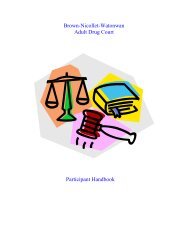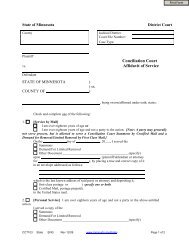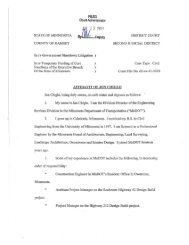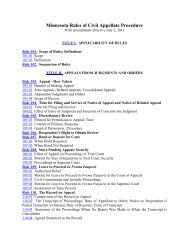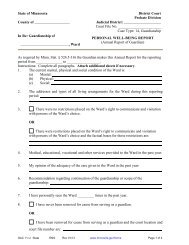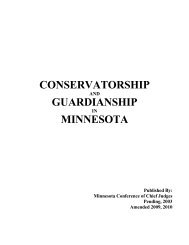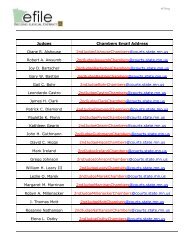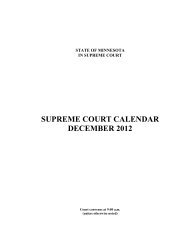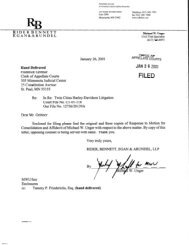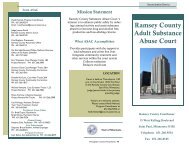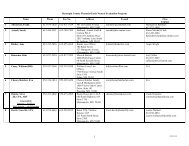1989-03-24 Comments of Star Tribune.pdf - Minnesota Judicial Branch
1989-03-24 Comments of Star Tribune.pdf - Minnesota Judicial Branch
1989-03-24 Comments of Star Tribune.pdf - Minnesota Judicial Branch
You also want an ePaper? Increase the reach of your titles
YUMPU automatically turns print PDFs into web optimized ePapers that Google loves.
The report also emphasizes the pivot01 role played by the presiding judge<br />
in controlling the media coverage. A permanent rule permitting<br />
electronic media coverage <strong>of</strong> court proceedings was adopted by the<br />
California <strong>Judicial</strong> Council effective July 1, 1984.<br />
Arizona's 1983 report on its 1982-83 experimept is in Cameras and<br />
Recorders in Arizona's Trial Courts, An Evaluation <strong>of</strong> the Experiment by<br />
Rob Raker. The generally favorable response to the experiment led to the<br />
rules being made permanent in 1983. A summary <strong>of</strong> the evaluation is<br />
enclosed.<br />
The report <strong>of</strong> the <strong>Minnesota</strong> Advisory Commission on Cameras in the<br />
Courtroom to the <strong>Minnesota</strong> Supreme Court <strong>of</strong> January 11, 1982, is also<br />
enclosed. This favorable report recommended that the Supreme Court<br />
permit video coverage <strong>of</strong> court proceedings on an experimental basis.<br />
Also enclosed is the Report on Pilot Project on the Presence <strong>of</strong><br />
Cameras and Electronic Equipment in the Courtroom compiled by Judge Guy<br />
E. Humphries, Jr., Division B, Ninth <strong>Judicial</strong> District Court, Parish <strong>of</strong><br />
Rapides, State <strong>of</strong> Louisiana. Again, the evaluation favored the use <strong>of</strong><br />
cameras, noting that the fears <strong>of</strong>ten expressed about the presence <strong>of</strong><br />
cameras were unfounded and that no loss <strong>of</strong> dignity or decorum was<br />
apparent.<br />
In addition to state evaluations, recent articles have tended to<br />
favor use <strong>of</strong> video equipment. Enclosed are:<br />
1. "Cameras in Court" (1985 Report.to the Governor and Legislature,<br />
<strong>Judicial</strong> Council <strong>of</strong> California, pp. 23-27). This report prints<br />
the text <strong>of</strong> the California Rule allowing video coverage and<br />
points to minor problems such as elimination <strong>of</strong> shutter noise<br />
caused by still cameras and close range photographs <strong>of</strong> jurors.<br />
2. "Digest (Iowa)" (State Court Journal, volume 8, November 4, p.<br />
34). After four years <strong>of</strong> experiments with cameras in the<br />
courtroom <strong>of</strong> 190 trials, no serious problems-were reported, with<br />
jury exit polls showing media coverage had little effect on<br />
trial participants.<br />
3. "Florida Survey Concludes Electronic Coverage Doesn't Interfere<br />
with Justice" (Court News, Newsletter <strong>of</strong> the Alabama <strong>Judicial</strong><br />
System, Volume 2, Number 11, 1978, p. 14). This survey <strong>of</strong> more<br />
than 2000 jurors, witnesses and court employees reported that<br />
televising courtroom proceedings did not disrupt trials or<br />
interfere with judicial administration.<br />
A negative reaction to courtroom cameras can be found in "'No' on<br />
Courtroom Cameras" (State Bar <strong>of</strong> Michigan Newsbriefs, Volume V. Number 8,<br />
September, 1982>, which is also enclosed. While this was a national<br />
survey <strong>of</strong> 600 attorneys, disapproval <strong>of</strong> cameras was greatest where used<br />
least and among older lawyers.<br />
MAH:caw<br />
Encl.



